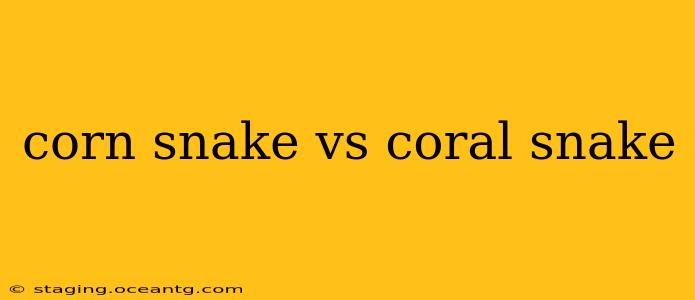Corn snakes and coral snakes are often confused due to their striking similarities in coloration. This can be a dangerous mistake, as coral snakes are highly venomous, while corn snakes are completely harmless. This guide will delve into the key differences between these two species, helping you confidently distinguish them and ensuring your safety.
What are the Key Differences Between Corn Snakes and Coral Snakes?
The most crucial difference lies in their venom: coral snakes are venomous, while corn snakes are not. However, identifying them visually requires careful observation of their color patterns. While variations exist within each species, a helpful mnemonic device is often used: "Red on yellow, kill a fellow; red on black, venom lack." This rhyme, however, isn't foolproof, as some coral snake variations might not perfectly adhere to this rule. Therefore, relying solely on this rhyme is risky.
What is the Difference in Their Appearance?
Both corn snakes and coral snakes exhibit vibrant colors and patterns, but closer inspection reveals key distinctions:
Banding Patterns:
-
Coral Snakes: Coral snakes typically have narrow, distinct bands of red, yellow/cream, and black that encircle their entire body. These bands are usually of equal width and clearly defined.
-
Corn Snakes: Corn snakes also possess bands, but these are often broader, less defined, and may not completely encircle the body. The colors are also less vibrant, and the patterns are more variable.
Head Shape and Size:
-
Coral Snakes: Coral snakes have a relatively small, rounded head that is not distinctly different from their neck.
-
Corn Snakes: Corn snakes possess a slightly larger head that is noticeably wider than their neck.
Behavior:
-
Coral Snakes: Coral snakes are generally shy and secretive, preferring to avoid confrontation. They are rarely aggressive unless severely provoked.
-
Corn Snakes: Corn snakes are also relatively docile but tend to be more active and easier to observe than coral snakes.
How Can I Tell Them Apart Without Getting Too Close?
The safest approach to identifying a snake is to maintain a safe distance and observe its characteristics from afar using binoculars if possible. If you are unsure, it's always best to err on the side of caution and assume it is a venomous snake. Never attempt to handle a snake you cannot confidently identify.
Are Corn Snakes Poisonous?
No, corn snakes are not poisonous or venomous. They are non-venomous constrictors, meaning they kill their prey by constriction rather than using venom. They are popular pet snakes due to their docile temperament and attractive patterns.
Are Coral Snakes Dangerous?
Yes, coral snakes are highly venomous. Their venom is neurotoxic, affecting the nervous system. A bite from a coral snake requires immediate medical attention. It’s crucial to seek professional medical help immediately if bitten.
What Should I Do If I See a Snake I Suspect is a Coral Snake?
- Maintain a safe distance. Do not attempt to approach or handle the snake.
- Observe the snake carefully from a distance. Note its color patterns and other characteristics. Take pictures if possible, but only from a safe distance.
- Contact local wildlife authorities or animal control. They can identify the snake and take appropriate action.
- If bitten, seek immediate medical attention.
What is the Habitat of Corn Snakes and Coral Snakes?
Both snakes inhabit different areas. Knowing their general location can aid identification. Research the typical habitats of these species in your region.
By understanding the key differences in appearance, behavior, and venom, you can confidently differentiate between a harmless corn snake and a dangerous coral snake. Remember, when in doubt, always prioritize safety and seek professional assistance.
